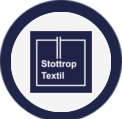
STRETCH 300 FR material is a flame retardant light-acoustic fabric with a sympathetic, soft and textile surface.
The special feature is the stretchability of the fabric. Common stretch materials are knitted or warp knitted. Light can shine through the holes in the stitches.
STRETCH 300 FR is different:
- woven yet flexible
- diffuse surface without pinholes
- soft
- crease-resistant
- easy to process
- smaller construction depths are possible
Acoustics:
This fabric itself is capable of significantly improving the acoustics of a room. The use of glass, concrete and solid floors results in a reverberant environment in many new buildings. The result is unwanted echoing that greatly impairs the understanding of conversations.
STRETCH 300 FR acts like a sponge that absorbs sound waves. Reflections are prevented from hitting the ear a second time or overlaying and obstructing other sound waves.
An additional absorber foam or fleece becomes unnecessary – which saves costs.
The sound absorption coefficient has the value of: αw = 0.40 (MH).
More important than the above average value is the range of 500 – 2,000 Hz relevant for human speech. Here an absorption maximum of up to 0.55 is achieved.
For use in public buildings with high audience frequency, it meets the requirements of low flammability and is certified according to the EN 13501-1, B-s1, d0 standard.
STRETCH 300 FR is used in a wide range of applications:
Backlighting:
Whether natural light, fluorescent tubes or LED technology, in a light box, on curved frames or simply braced; STRETCH 300 FR is a diffuser that provides homogeneous light distribution, completely without “pinhole” effects.
Incident light:
The pure white surface provides a bright, reflection-free plane to illuminate, suitable for use as a beamer screen, among other applications.
Light sail:
Due to the tensile material, large spans and 3-dimensional surfaces are possible.
Printing medium:
For the application of ornaments, pictures, photos or signposts, the surface is prepared for various printing methods: Screen printing, digital printing as well as UV- printing, thermal sublimation printing, direct printing and latex printing.




